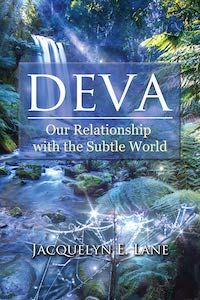
Deva: Our Relationship with the Subtle World, by Jacquelyn E. Lane
Findhorn Press, 978-1644110741, 320 pages, June 2020
Deva: Our Relationship with the Subtle World by Jacquelyn E. Lane is a title that anyone who is serious about the undertaking of engaging and communicating with the natural world should read. Lane is an educator by profession and this is quite apparent in the organization of the book. She has also been involved in the study of metaphysics for 50+ years, and this experience is the underpinning of this particular title and its teachings regarding the work of collaboration with the laws and spirits of nature through the development of a relationship of mutual respect, stewardship, and care.
…. Life is a great song. From the rocks that seem to be still to the bubbling water of a stream that flows over them. From the uncurling leaves of small plants to giant trees. From the quiet hamlets to the teeming cities. It’s all singing-notes within tunes, tunes within themes, themes within symphonies.1
These words flow from the pages and are the first lines of the Introduction. Simply reading them draws the reader in for a closer look and the journey that is about to unfold in the voluminous content that follows, if truly heard and appreciated, becomes a timeless and timely composition of nature.
Deva is a fitting publication for the Findhorn Press and the mission of the Findhorn Community. To fully appreciate the need for this book a little history of The Findhorn Community will offer some background. The Findhorn Community developed from the resettlement of Peter and Eileen Caddy, their children, and Dorothy Maclean to the Findhorn Bay Caravan Park in 1962. The three had dedicated their lives to the pursuit of esoteric studies and applications and the barren soil of the caravan park provided the setting of opening to the land spirits and guidance in how to “live” in harmony on the land. All that was planted in accord with the aid of the Devas, elementals, and other nature spirits grew beyond expectation, and the garden became a marvel within the horticultural world.2
This book will please both the scientist and the esotericist in its content. Science and the esoteric philosophies are fast becoming great friends and supports to one another as we learn more about quantum physics and the nature of matter and energy. There is still quite a bit of ways to go in the overlap, but more books such as this will help in creating that bridge of cross-pollination. In reading the biography of the author we learn that Deva, was shortlisted for the 2019 Ashton Wylie Unpublished Manuscript Awards: an affirmation of the need for this material to be given the proper consideration it is due.
The Introduction holds the keys to everything that the reader needs to know regarding what to expect from this book and what is required from the reader by way of open mind and willingness to become “involved” in the world that surrounds us in a more authentic way. So, for some this book will definitely be one of those slow and steady reads that leaves you with questions and wanting to know more-and do more-with each paragraph. And, for others it will affirm everything they have known and are currently working towards.
Lane gives a clear and simple (ironically, for a very complex subject) introduction to who/what the deva are and the use of that term in the content that follows…
…. Deva is an ancient Sanskrit word from India meaning “Being of Light”… They sing ideas into form. It is the deva that cause us to exclaim, “Wow, this is a special place. It feels so alive!”…. they are within every atom. Deva are the faeries in the grass. They are the vast energy of sea, wind and mountains….To really (understand) deva, we need to realize that deva is a kingdom of substance and form-the world of matter both solid and subtle.3
Deva is separated into three parts comprising a total of eighteen chapters. In some cases more is more, but this is one case in which it feels after reading that there were too few chapters — meant in the most complimentary of ways. There is a strong infusion of Theosophical principles throughout the book, but these are incorporated in such a way that the reader does not have to be a student of Theosophy to understand what is being said. The Bibliography is filled with resources of books, articles and recordings sourced from some of the most prominent and respected presenters of physics, botanists, metaphysicians, theosophists and more. I would consider this work as a required text for a course in how to become a participant in the worlds shared by humanity and nature.
Part One: Elemental Tunes dives right in to exploring the inhabitants of our greater etheric planes of Earth that are the pure expression of energy from densest to the more rarified. Each chapter contained within this section opens the reader to a new experience of the devic kingdom and provides the basis upon which the individual can extrapolate and come to their own conclusions regarding how the energy of what is unseen is often more powerful than that seen as we become more aware of what is within and surrounds us…
… The deva kingdom is everywhere, say the ancients-an Intelligence infused into matter at every level of density.4
Part Two: Who’s Singing Your Song encompasses the aspects of emotion, thought and those forms of deva that we create. I particularly enjoyed chapter eight “Emotion” and Lane’s attention to the power of our emotions as fueling many of the components of the spiritual evolution of devas, humanity and all of the sea of matter, formed and formless. This chapter really calls to the reader to examine their emotional baggage and presumptions that create patterns of illusion that are in contradiction to the organic nature of the deva and humanity. As I moved through the information in Part Two, I was reminded of the deep connection we have in mind and heart and the impact, not only upon ourselves, but everything from the densest of matter to the most subtle. These also inherently include the discordant relationships and often-resultant ill effects that communication with the deva kingdom may have if the individual is not aligned within him/herself.
Part Three: Symphonies could be compared to the final movement of a stirring orchestral composition. All of the instruments have a role that is both profound and subtle in their impact. The climax reaches its peak and we are left in the after-glow of a symphonic masterpiece that is inspiring and has reached deeply into the fibers of all of our being. These final chapters of Deva speak to active participation in the natural world and those aspects of the deva kingdom we are more familiar with as iconic representations of nature. Trees, plant life, geographic regions, climate change and planetary deva are some of the topics discussed.
The final two chapters, “Deva, Religion and Pan” and “Consciousness,” were appropriately placed in the organic flow of this writing. These are topics that are usually captured at the beginning of a discourse such as this, and in doing so, feel like the perfunctory ‘getting that out of the way” manner in which they are often treated. In this case, this very important material punctuates the final notes of this symphony, and it is always those last notes that are remembered, even if the rest is forgotten.
Lane offers these thoughts as conclusion and calls us to re-member our true state of being…
…The Great Song dances out of the One from the highest to the lowest. We can see its effects all around using every kingdom (animal, deva, mineral, etc..) beside us. We can hear it directly when we cease to place our individuality before that One Life. Yet, from the beginning it has called on our inner ear relentlessly until we have learnt to listen and, in listening, we hear the song of our own Light as well.5
Deva: Our Relationship with the Subtle World has been an immensely satisfying book to read. and I am looking forward to the many re-reads I will give as my own journey in connecting more deeply to the Deva continues. We are at a crossroads of choice and the next steps we take collectively, but most importantly individually, will determine so much more than what we see of the physical world. The more reminders we have about our place in this “symphony of life,” and the more books that are brought forward that will speak to all levels of engagement and practice will be steps in the right direction. Open your eyes with new wonder and call out from your highest intention and you may just be surprised at who/what calls back in reply.

Robin Fennelly is an Elder within the Assembly of the Sacred Wheel Tradition [www.sacredwheel.org]. She is a dancer, teacher, astrologer, author, ritualist and seeker of all things of a spiritual nature. Her writings and classes incorporate a deep understanding of Eastern practice and Western Hermetics and bring a unique perspective towards integration and synthesis of the Divine and Mundane natures of our being. She is a mother of five and lives in Eastern PA with her husband of 45+ years.
References
- page 11
- Read more about the Findhorn Foundation
- page 13
- page 25
- page 306

Indeed a thrilling book encompassing all aspects of life in any form. It opens our eyes to accept that the energy that pulls all together is also behind even a speck of dust.
As true to her style Jacquelyn gives ‘word pictures’ with such clarity so they become visually etched in our mind.
Brilliant and so readable again and again. Best wishes for all Jacquelyn writes and publishes so we may share her wonderful talent.